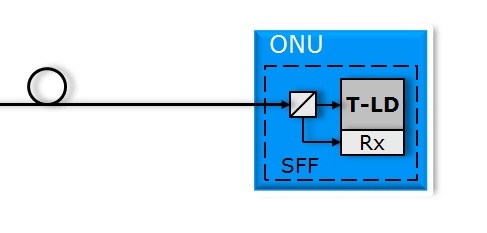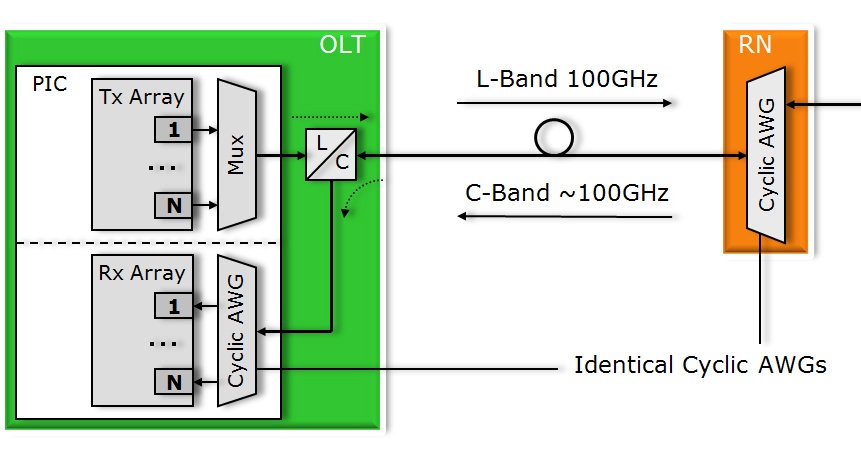Bringing WDM-PON to market
 Tuesday, September 7, 2010 at 6:48AM
Tuesday, September 7, 2010 at 6:48AM Significant power, size and cost challenges must be overcome before WDM-PON will be widely deployed.

"We see just one way to bring down the cost, form-factor and energy consumption of the OLT’s multiple transceivers: high integration of transceiver arrays"
Klaus Grobe, ADVA Optical Networking
Considerable engineering effort will be needed to make next-generation optical access schemes using multiple wavelengths competitive with existing passive optical networks (PONs).
Such a multi-wavelength access scheme, known as a wavelength division multiplexing-passive optical network (WDM-PON), will need to embrace new architectures based on laser arrays and reflective optics, and use advanced photonic integration to meet the required size, power consumption and cost targets.
Current PON technology uses a single wavelength to deliver downstream traffic to end users. A separate wavelength is used for upstream data, with each user having an assigned time slot to transmit.
Gigabit PON (GPON) delivers 2.5 Gigabit-per-second (Gbps) to between 32 or 64 users, while the next development, XG-PON, will extend GPON’s downstream data rate to 10 Gbps. The alternative PON scheme, Ethernet PON (EPON), already has a 10 Gbps variant. Vendors are also extending PON’s reach from 20km to 80km or more using signal amplification.
But the industry view is that after 10 Gigabit PON, the next step will be to introduce multiple wavelengths to extend the capacity beyond what a time-sharing approach can support. Extending the access network's reach to 100km will also be straightforward using WDM transport technology.
The advent of WDM-PON is also an opportunity for new entrants, traditional WDM optical transport vendors, to enter the access market. ADVA Optical Networking is one firm that has been vocal about its plans to develop next-generation access systems.
“We are seriously investigating and developing a next-generation access system and it is very likely that it will be a flavour of WDM-PON,” says Klaus Grobe, senior principal engineer at ADVA Optical Networking. “It [next-generation access] must be based on WDM simply because of bandwidth requirements.”
The system vendor views WDM-PON as addressing three main applications: wireless backhaul, enterprise connectivity and residential broadband. But despite WDM-PON’s potential to reduce operating costs significantly, the challenge facing vendors is reducing the cost of WDM-PON hardware. Indeed it is the expense of WDM-PON systems that so far has assigned the technology to specialist applications only.
 A non-reflective tunable laser-based WDM-PON ONU. Source: ADVA Optical NetworkingAccording to Grobe, cost reduction is needed at both ends of the WDM-PON: the client receiver equipment known as the optical networking unit (ONU) and the optical line terminal (OLT) housed within an operator’s central office.
A non-reflective tunable laser-based WDM-PON ONU. Source: ADVA Optical NetworkingAccording to Grobe, cost reduction is needed at both ends of the WDM-PON: the client receiver equipment known as the optical networking unit (ONU) and the optical line terminal (OLT) housed within an operator’s central office.
ADVA Optical Networking plans to use low-cost tunable lasers rather than a broadband light source and reflective optics for the ONU transceivers. “For the OLT, we see just one way to bring down the cost, form-factor and energy consumption of the OLT’s multiple transceivers: high integration of transceiver arrays,” says Grobe.
This is a considerable photonic integration challenge: a 40- or 80-wavelength WDM-PON uses 40 or 80 transceiver bi-directional clients, equating to 80 and 160 wavelengths. If 80 SFPs optical modules were used at the OLT, the resulting cost, size and power consumption would be prohibitive, says Grobe.
ADVA Optical Networking is working with several firms, one being CIP Technologies, to develop integrated transceiver arrays. ADVA Optical Networking and CIP Technologies are part of the EU-funded project, C-3PO, that includes the development of integrated transceiver arrays for WDM-PON.
Splitters versus filters
One issue with WDM-PON is that there is no industry-accepted definition. ADVA Optical Networking views WDM-PON as an architecture based on optical filters rather than splitters. Two consequences result once that choice is made, says Grobe.
One is insertion loss. Choosing filters implies arrayed waveguide gratings (AWGs), says Grobe. “No other filter technology is seriously considered for WDM-PON if filters are used,” he says.
With an AWG, the insertion loss is independent of the number of wavelengths supported. This differs from using a splitter-based architecture where every 1x2 device introduces a 3dB loss - “closer to 3.5dB”, he says. Using a 1x64 splitter, the insertion loss is 14 or 15dB whereas for a 40-channel AWG the loss can be as low as 4dB. “I just saw specs of a first 96-channel AWG, even that one isn’t much higher [than 4dB],” says Grobe. Thus using filters rather than splitters, the insertion loss is much lower for a comparable number of client ONUs.
There is also a cost benefit associated with a low insertion loss. To limit the cost of next-generation PON, the transceiver design must be constrained to a 25dB power budget associated with existing PON transceivers. “This is necessary to keep these things cheap, possibly dirt cheap,” says Grobe.
The alternative, using XG-PON’s sophisticated 10 Gbps burst-mode transceiver with its associated 35dB power budget, achieving low cost is simply not possible, he says. To live with transceivers with a 25dB power budget, the insertion loss of the passive distribution network must be minimised, explaining why filters are favoured.
The other main benefit of using filters is security. With a filter-based PON, wavelength point-to-point connections result. “You are not doing broadcast,” says Grobe. “You immediately get rid of almost all security aspects.” This is an issue with PON where traffic is shared.
Low power
Achieving a low-power WDM-PON system is another key design consideration. “In next-gen access, it is absolutely vital,” says Grobe. “If the technology is deployed on a broad scale - that is millions of user lines – every single watt counts, otherwise you end up with differences in the approaches that go into the megawatts and even gigawatts.”
There is also a benchmarking issue, says Grobe: the WDM-PON OLT will be compared to XG-PON’s even if the two schemes differ. Since XG-PON uses time-division multiplexing, there will be only one transceiver at the OLT. But this is what a 40- or 80-channel WDM-PON OLT will be compared with, even if the comparison is apples to pears, says Grobe.
WDM-PON workings
There are two approaches to WDM-PON.
In a fully reflective architecture, the OLT array and the ONUs are seeded using multi-wavelength laser arrays; both ends use the lasers arrays in combination with reflective optics for optical transmission.
ADVA Optical Networking is interested in using a reflective approach at the OLT but for the ONU it will use tunable lasers due to technical advantages. For example, using the same wavelength for the incoming and modulated streams in a reflective approach, Rayleigh crosstalk is an issue when the ONUs are 100km from the OLT. In contrast, Rayleigh crosstalk at the OLT is avoided because the multi-wavelength laser array is located only a few metres from the reflective electro-absorption modulators (REAMs).
REAMs are used rather than semiconductor optical amplifiers (SOAs) to modulate data at the OLT because they support higher bandwidth 10 Gbps wavelengths. Indeed the C-3PO project is likely to use a monolithically integrated SOA-REAM for this task. “The reflective SOA is narrower in bandwidth but has inherent gain while the REAM has loss rather than gain – it is just a modulator,” says Grobe. “The combination of the two is the ideal: giving high modulation bandwidth and high transmit power.”
 The integrated WDM-PON OLT. In practice the transmit array uses a reflective architecture based on SOA-REAMs and is fed with a multi-wavelength laser source. Source: ADVA Optical Networking
The integrated WDM-PON OLT. In practice the transmit array uses a reflective architecture based on SOA-REAMs and is fed with a multi-wavelength laser source. Source: ADVA Optical Networking
For the OLT, a multi-wavelength laser is fed via an AWG into an array of SOA-REAMs which modulate the wavelengths and return them through the AWG where they are multiplexed and transmitted to the ONUs via a demultiplexing AWG. An added benefit of this approach, says Grobe, is that the same multi-wavelength laser source can be use to feed several WDM-PON OLTs, further decreasing system cost.
For the upstream path, each ONU’s wavelength is separated by the OLT’s AWG and fed to the receiver array. In a WDM-PON system, the OLT transmit wavelengths and receive wavelengths (from the ONUs) operate in separate optical bands.
Grobe expects its resulting WDM-PON system to use 40 or 80 channels. And to best meet size, power and cost constraints, the OLT design will likely implemented as a photonic integrated circuit. “We are after a single PIC solution,” he says. “It is clear that with the OLT, integration is the only way to meet requirements.” A photonically-integrated OLT design is one of the products expected from the C-3PO project, using CIP Technologies' hybrid integration technology.
ADVA Optical Networking has already said that its WDM-PON OLT will be implemented using its FSP 3000 platform.
- To see some WDM-PON architecture slides, click here.



Reader Comments (6)
If we think for WDM-PON as the next generation PON, it should also support low bandwidth users' demands. That's because some countries do not need high bandwidth for now, even though they may do in future as new services such as HDTV, 3D TV, 3D gaming emerge.
Such countries will think that if they implement GPON as the PON infrastructure, they will lose the cost battle if they then switch to WDM-PON. Because WDM-PON is costly they may not take this step, and here comes the question:
Could WDM-PON supports low bandwidth users - less than 100Mbps - like GPON? It then has the ability to raise its bandwidth without any extra cost (just using configuring) and without increasing the BER?
If we got answers based on a real investigation, this could revive the myth that WDM-PON is the next-generation PON, because many countries will take the shortcut and build WDM-PON without thinking of GPON as the basic infrastructure.
Thanks, Ibrahim. You raise some good points. WDM-PON was not developed with low-bandwidth users in mind. It’s been designed to provide carriers with a viable transport solution that can answer the explosion in bandwidth demand; a demand that will only continue to grow as the applications you highlight evolve.
Currently, WDM-PON systems are a little more expensive than GPON alternatives, but the potential to accommodate bandwidth growth is significantly higher and we don’t see any market where the demand for broadband is actually static or decreasing.
One solution for countries concerned about the cost would be to start with the WDM transmission equipment, but use a smaller switch fabric (which is necessary) in the OLT. In case of bandwidth growth, the switch can be upgraded.
However, as you highlighted, the cost associated with upgrades and suchlike can become expensive. If a country is truly building a next-gen infrastructure, WDM-PON is the only long-term solution.
Thanks,
Klaus
"One solution for countries concerned about the cost would be to start with the WDM transmission equipment but use a smaller switch fabric (which is necessary) in the OLT. In case of bandwidth growth, the switch can be upgraded."
This way it seems that hybrid TDM-WDM-PON technology would be the best solution, because if we assume that the backbone is built with DWDM transmission equipment, we can just implement this technology at the access layer to cope with demand as required. So no matter how the bandwidth increases, just adding some splitters will satisfy the hunger of each user, even though this needs continual upgrading for both the configured bandwidth per user and splitters. But it will decrease the cost if we assume that more than 30 users share two wavelengths rather than sharing the AWG.
So here comes another competition, between WDM-PON and TDM-WDM-PON, The question is: which is best in our case?
OK, another question: In WDM-PON, there is a standard being used for the supported bandwidth per user, which is 100Mbps,155Mbps, 312Mbps, 622Mbps, 1.25Gbps, 2.5Gbps and 10Gbps.
Is the convergence of these supportable bandwidths done using configuration or by installing new devices?
Hi Ibrahim
Thanks for your two further questions.
In regards to your question from October 5:
What I meant is a pure WDM/WDMA-PON (one wavelength pair per customer). Here, the photonics need to be implemented at day one, but at the OLT (PoP), a smaller switch can be installed which supports, for example, 100 Mbps per client. If more bandwidth is required, the switch needs upgrading, not the photonics.
I was not referring to the so-called WDM/TDMA-Hybrid-PON. We can show that a simple (pure) WDM-PON can outperform ANY other (PON) approach in both cost and power consumption, for high sustained bit rates in excess of, for example, 200 Mbps per client. Within the related cost calculations, the per-port (per-client) fraction of the AWG is NOT the main contributor. Low cost for a WDM-PON is mainly achieved through low-cost tuneables for the ONUs, and highly integrated multi-channel transceiver arrays for the OLT.
Again: if the initial requirement is for lower than 100 Mbps sustained, AND in the longer run there is no significant bandwidth increase, then GPON is the answer. If the safety margin for UHDTV, 3D-HDTV etc. - as (time-shifted) unicast, VoD, or even peer-to-peer – is required, then WDM-PON will be the better choice.
In regards to your question from October 17:
I’m not aware of these bit rates being standardized. In those few WDM-PON installations, some of these rates have been used. In a well-designed WDM-PON, these rates (and other, odd rates) can be supported without installing new devices every time.
Thanks,
Klaus
Interesting read. How does this work compare with that of the SARDANA project?
http://www.ict-sardana.eu/index.php?name=News